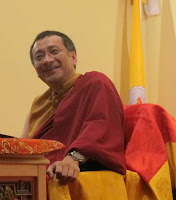 What is science saying that the Buddha explained thousands of years ago? We speak of theoretical subatomic particles, whereas the Buddha explained kalapas (the "particles of perception") in detail from intimate knowledge of materiality ("Futurama").
What is science saying that the Buddha explained thousands of years ago? We speak of theoretical subatomic particles, whereas the Buddha explained kalapas (the "particles of perception") in detail from intimate knowledge of materiality ("Futurama"). His Eminence Dzogchen Ponlop Rinpoche, who is in the country after 20 years, shares his opinion on the relevance of Buddhism in 21st century.
His Eminence Dzogchen Ponlop Rinpoche, who is in the country after 20 years, shares his opinion on the relevance of Buddhism in 21st century.The seventh Dzogchen Ponlop Rinpoche, Karma Sungrap Ngedon Tenpa Gyaltsen, is a leading Buddhist teacher in North America and an advocate of American and Western Buddhism, a meditation master, and an author of five books on mind and awakening.
BHUTAN - The following are excerpts from a talk delivered at the Royal Institute of Management.
Shakyamuni, the Buddha Gautama, was a human being who achieved the highest wisdom, peace, and realization a mind can achieve.
Siddhartha was born a prince. He had all the material enjoyments one can desire. It was not as if he were forced to meditate, become a recluse, or practice austerities. He, in fact, chose to be a great spiritual practitioner on a quest to find the liberating truth.
Siddhartha became a great master of meditation by choice. And when he became the Buddha, his teachings emanated from a realized human master, which made them pragmatic and useful teachings for us as human beings. [They are also useful to near-Earth akasha devas not seduced by the pleasures of higher order worlds].
 The microcosm is directly perceptible to the higher mind (adhicitta) temporarily released from the defilement and purified by the various material absorptions (rupa jhanas) called "right concentration."
The microcosm is directly perceptible to the higher mind (adhicitta) temporarily released from the defilement and purified by the various material absorptions (rupa jhanas) called "right concentration."
Many times in Asia, when we hear of Dharma, we get scared. We think of it as incomprehensible, something for the monks and nuns to deal with. But Dharma is simply a genuine "science of mind" because, if one looks at the Buddha’s Teaching, there is only one message. That message is how to work with the mind/heart .
At some point every one of us deals with the mind. Dharma is about how we can discover its true potential -- how we can work with undesirable habits and negative mental states and transform them into something positive.
The Buddha taught that we have the heart of Buddha -- a Buddha nature. That is, we have the heart of awakening and enlightenment: Enlightenment is nothing outside. It is inside our heart, which is full of wisdom and compassion that goes beyond any sense of self-interest.
He said that even if we are compassionate towards other sentient beings, there is usually a kind of self-interest, that of accumulating merit. When we give a quarter to a beggar, we are doing that out of compassion. But when we are motivated by self-interest such as the hope that it will bring us good karma that would help us in the future [we may be taking away from our development of compassion, which is based on helping others].
Although that kind of compassion is good and worth practicing, we must realize that there is some measure of self-interest being cultivated. Genuine Buddha nature is beyond that kind of ego.
Dharma is the discovery of selflessness, unselfishness, freedom from the oppression of being concerned with ourselves. Genuine [altruistic metta] love and compassion is liberating and also helps us discover the wisdom of the Buddha, which sees true reality like emptiness [the impersonal nature of not only us but of all "things"].
The Buddha’s Teachings talk about emptiness. This is very relevant for the 21st Century, because the Buddha’s wisdom says that things are not as they appear. Western science, ancient and modern, speaks of "atoms" that we do not see forming things we do see. [Now even those building blocks have become particles.]
Scientists say there is no such thing as a table, only atoms [which are by far merely empty space]. The shapes and colors we see are not necessarily there [but just vibratory rates]. Now modern particle physics is discovering quarks and developing string and other theories. So it is slowly coming to the conclusion that even atoms do not exist.
Emptiness
Here we are every year coming closer to the Buddha’s teaching and science uniting. The Buddha taught this theory in his Teachings. We find the atomic theory in the earliest (Theravada) texts [that apparently the ancient Greeks borrowed from India], a well developed mind theory in Mahayana, and emptiness theory in Vajrayana. Now modern science is catching up with the Buddha’s Teachings.
The Buddha taught 2,600 years ago. Therefore, we can see the relevance of teachings about emptiness to scientific views today.
Although modern science is on the way to discovering emptiness, it is not yet there, technically or emotionally. In just the same way, most of us are not ready to let go of the sense of self the mind clings to. There is great fear about losing the self.
Asians are born in to a rich culture of Buddhist teachings with a long tradition of spirituality. It is a precious heritage to be preserved. But we can only do this when we truly understand it. The only fault here is that since we are born into it, we take it for granted and do not question it.
Wisdom and understanding emerge from questioning and investigating not from being handed or memorizing answers.
As Asian Buddhists, we must ask questions, go deeper, and discover the Buddha’s Teachings and bring it into our heart.


































































































































































































































No comments:
Post a Comment